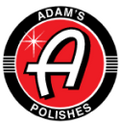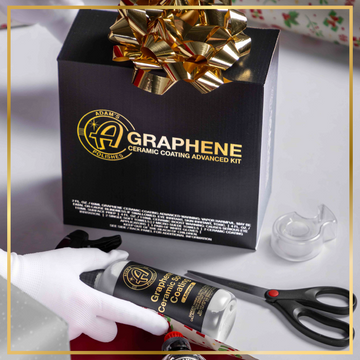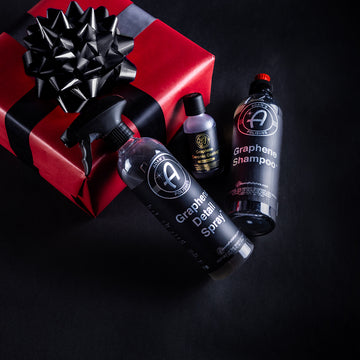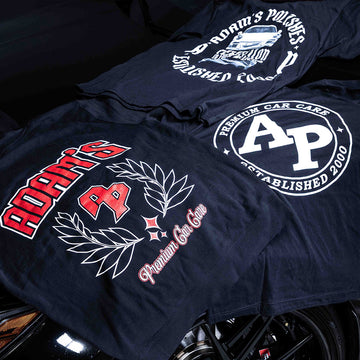There are a large amount of wheel finishes available on new vehicles and aftermarket wheel options, and plenty of vintage types of wheels as well, so it’s very important to use the proper cleaners, accessories, and process to not damage the finish. Clear coated, chrome, matte, satin, raw polished aluminum, powder coated, and anodized are the most common wheel finishes that you will find yourself cleaning. We offer a few different options when it comes to chemical cleaners for handling all of these different wheel finishes and a few for tires as well. It’s important to know which ones will work best for each particular vehicle, so we’ll take a look at each, starting from most aggressive to least aggressive. There is a lot to cover to explain why you should and should not do certain things when cleaning different wheel types, so these first two sections of the blog are going to be the longest - but spending time up front on proper cleaning is very important in order for the protection process to go smoothly and last the longest.
Wheel Cleaner
Adam’s Wheel Cleaner has evolved with a few updates since its release in 2013 as Deep Wheel Cleaner. The original version was a transparent reddish-pink color with a very potent scent. It was a heavy duty cleaner with an iron activator (Sodium Thioglycolate) that would cause the chemical to turn purple as it began to interact with and dissolve brake dust on the wheel surface, brake calipers, and rotors. Over the years, the name was simplified to Wheel Cleaner, and the third and most current version has a thicker, gel-like consistency now with a blue-green color. It’s still just as effective and turns purple as it interacts with the iron deposits in the brake dust. The scent is further improved but still carries some potency due to the sulfur in the Sodium Thioglycolate. In some cases, the iron removing aspect of Wheel Cleaner allows it to nearly self-clean the wheel, by simply spraying it on, allowing it to work and turn purple, and then rinsing it off thoroughly with a pressure washer or strong blast from a hose; however, in most cases you will need to agitate it with a cleaning tool like the Rubberized Wheel Brush or Wheel Woolie.
Wheel Cleaner is our strongest chemical for removing heavy brake dust buildup from high-performance brakes found on most performance vehicles and aftermarket big brake kits. How can you tell if your vehicle has high-performance brakes and brake pads? Brembo brakes and other large calipers, often powder coated in a bright color, are almost an immediate sign of incredible braking performance but large amounts of brake dust. A second example, let’s say that your truck or sport sedan has silver wheels, but you notice the wheels are turning dark gray with brake dust after just a few drives - this is another scenario where your vehicle most likely has higher performance brake pads.
These metallic brake pads often contain metals such as iron, copper, and steel composites for this level of performance; however they do indeed make a lot of dust, that if left untreated, may start to leave yellow, orange, or brown staining into the creases and outer spokes of your wheel as the dust bonds to the finish from high temperatures. Wheel Cleaner and the Trim & Lug Nut Brush will be the best option in this scenario to remove these iron stains effectively, as our other cleaning options most likely will not be aggressive enough. Organic brake pads, very common in most non-performance vehicles, may not show the purple color-change with Wheel Cleaner as much or at all, since they produce less dust and are made of non-metal materials like rubber, kevlar, fiberglass, and resin. Ceramic brake pads offer even less dust, but can still show the purple color-change, since the ceramic material is combined with copper.
There are a few wheel finishes that we do not recommend using Wheel Cleaner with, where other chemicals are required instead. On raw aluminum and raw polished aluminum wheels, the exposed metal can potentially become cloudy or hazy after using Wheel Cleaner. This would then require polishing them back out with Metal Polish #2, which you may not want to do every time you clean your wheels. On aftermarket anodized wheels, Wheel Cleaner can stain the anodized finish. Anodizing is an electrochemical oxidation process of an aluminum surface that produces a stable film of colored aluminum oxides. In other words, anodizing is in the metal rather than a layer that sits on top of the metal like paint, powder coat, chrome, and so on. An anodized finish is durable and cannot chip, but raw aluminum is porous and is still porous after the anodizing process, so strong chemicals like Wheel Cleaner can work their way into the pores and cause staining and discoloration.
Powder coated wheels and calipers must also be cleaned with special care, especially if the powder coat is just a base color without a clear powder baked on top of the color layer. Wheel Cleaner can be used on powder coated wheels, but the wheels and calipers must be cool to the touch, you cannot let the cleaner dry on the wheel, and you must rinse it very thoroughly to avoid any issues like staining or fading of the powder coat. The same stipulations apply to gloss black, satin black, and matte black wheels as well. If you do not follow the precautions above, the Wheel Cleaner can cause drip stains or even a chalky appearance on some black wheels if used incorrectly.
Wheel & Tire Cleaner
Wheel & Tire Cleaner is a relatively new entry into our product lineup, but it has quickly become a customer favorite for how effective this one chemical is at cleaning heavily dirty wheels and tires, saving time and money in the process. While Wheel & Tire Cleaner does not contain the iron activating chemical that turns purple as it dissolves iron particles, it is still a very strong cleaner that is perfect for removing heavy road grime on your daily driver. It’s great to use on vehicles that have low-dust brake pads, or for maintenance cleaning when the wheels may not have as much brake dust buildup in between uses of our regular Wheel Cleaner. Because Wheel & Tire Cleaner is a strong chemical cleaner, it has the same safety precautions as Wheel Cleaner above, with the same notes on which types of wheels to avoid using it on entirely, or which to use with caution.
Wheel & Tire Cleaner is also extremely effective at removing brown discoloration from tires, called tire blooming. After spraying it on a tire, you will almost immediately begin to see streaks of brown residue bleed out of the sidewall of the tire. On some rubber compounds, it is even more effective than our Tire & Rubber Cleaner at cleaning the tire. It may only require one pass of spraying and scrubbing the tire to get it to near 100% clean, whereas with Tire & Rubber Cleaner, it can sometimes take 2 or 3 passes if a tire has been neglected and is very discolored. Wheel & Tire Cleaner will easily remove previous applications of VRT, Tire Shine, or Graphene Tire Dressing, in order to dress the tire fresh again. It is also the only chemical of ours that will remove our Tire Armor, which we’ll outline later in this blog.
Tire & Rubber Cleaner
Much like our Wheel Cleaner specifically targets and removes brake dust, Tire & Rubber Cleaner is a heavy duty degreaser that has surfactants and citrus solvents that target mold release agents on brand new tires as well as tire blooming, or discoloration, that can develop over the life of the tires. Tire & Rubber Cleaner is a high sudsing formula that removes silicones, greases, polymers, road grime, and previous dressings to leave your tires bare and looking like new. With the first pass of cleaning, you will see Tire & Rubber Cleaner foam up into an orange-brown color as it removes all of the contamination from the sidewall. After rinsing the tire, you’ll notice if you use Tire & Rubber Cleaner again for a second or third pass, the foam will eventually appear white. This is a good indication that you have the majority of the sidewall bare and clean. By stripping the sidewall of an old tire dressing, it will allow the new application of Tire Shine, VRT, Graphene Tire Dressing, or Tire Armor to spread onto the tire more evenly and last longer.
Tire & Rubber Cleaner isn’t just for tires. It does an excellent job of cleaning exterior rubber and plastic trim, turning chalky and oxidized trim nice and dark again. It is our most effective chemical at removing white wax stains from textured plastics on bumper inserts, truck bed rails, wiper cowls, and other trim pieces. It is the necessary first step in making exterior plastics as clean as possible before using Surface Prep and then coating the plastic with a product like Ceramic Spray Coating, or dying heavily faded plastic with our Ceramic Black Trim Restorer. Lastly, Tire & Rubber Cleaner works well on plastics and rubber hoses as an engine bay degreaser, and it also cleans inner fender liners really well when used with the Fender Brush. Keep in mind though that if your vehicle’s fender liners are carpeted, you will spend more time rinsing all of the chemical out of the synthetic carpet material.
All Purpose Cleaner
Our All Purpose Cleaner, or APC, is another heavy duty degreaser option that we offer. While it was not specifically designed to combat brake dust, it is still an effective cleaner for both tires and wheels. Where APC stands out though is in its cleaning power for inner fender liners, engine bay degreasing, and loosening exhaust residue and soot buildup on exhaust tips. All Purpose Cleaner is a concentrated formula that can be used full-strength for heavy degreasing or diluted for delicate tasks. It can be used to clean rubber floor mats, mud flaps, and even brushes and applicators pads when you’ve finished the detail session. As with Wheel Cleaner and Wheel & Tire Cleaner, we do not recommend using it on any of the delicate finish wheels we mentioned earlier - and never let it dry on any surface. One final caution is that APC should not be used on white vinyl, such as racing stripes, as it can potentially stain and discolor the material.
Eco All Purpose Cleaner
Adam’s Eco All Purpose Cleaner is a safer alternative to our heavy-duty All Purpose Cleaner and other options above. The “Eco” in the name means that it is eco-friendly on both you and the environment. It is a direct release to the environment product that is safe to breathe, will not leave your hands with a strong chemical odor, and will not pollute open streams, drains, and so on. It works great on most wheels, tires, and wheel wells to remove medium contamination, perfect to remove worn down Graphene Tire Dressing, Tire Shine, or VRT when you may not need the more aggressive cleaning strength of Tire & Rubber Cleaner to remove brown discoloration. Eco All Purpose Cleaner can be used as a degreaser for engine bays that may have more delicate painted areas that may not be clear coated and could fade, or aluminum components that may discolor, from stronger degreasers. Eco APC can be used on paint as well, provided the vehicle is in the shade and the paint is cool to the touch. It can be used to remove more stubborn contamination like tar, bug splatter, bird droppings, and sap, but since it is a degreaser it will weaken or remove wax or sealants that you have on the paint, so make sure to apply a fresh coat of protection if you use sealant or wax on the vehicle. Lastly, if you find you’ve ran out of Towel & Pad Revitalizer, Eco All Purpose Cleaner is a safe and powerful substitute for cleaning out machine polishing pads, applicator pads, and foam tire applicators without any damage to the foam material.
Eco Wheel Cleaner
If you’re hesitant on which cleaner to use on your wheels, whether they’re delicate aftermarket wheels or black factory wheels that have been stained by other cleaners in the past, our Eco Wheel Cleaner is recommended for you. Eco Wheel Cleaner is a safe wheel cleaning formula combined with the cleaning technology of our Eco All Purpose Cleaner discussed earlier. No matter the sensitive finish - gloss black, anodize, powder coat, polished aluminum, and more - when used properly, Adam's Eco Wheel Cleaner will not stain your wheels. This formula does not contain the iron activator chemical found in our normal Wheel Cleaner, so it does not turn purple during use.
Since Eco Wheel Cleaner is designed to be a very safe cleaning option for more specialized finishes, it may not be as effective at removing heavy brake dust buildup. It is, however, a perfect choice for maintenance cleaning after a wheel has been graphene coated or ceramic coated, when wheels typically will not require as harsh of chemicals for cleaning. Naturally derived surfactants in this formula generate nice foaming and detergent properties that are safe for the wheel, tire, and brake components - even very high-performance and expensive carbon ceramic rotors and brakes present in some exotic performance vehicles. One additional feature of Eco Wheel Cleaner is that it doesn’t have a very strong or lingering odor like our normal Wheel Cleaner and instead has a nice citrus scent. Like our Eco All Purpose Cleaner, Eco Wheel Cleaner is direct release to the environment, meaning there is no harm in it rinsing into drains, grass, etc.
Car Shampoo
Our Car Shampoo will be one of the most gentle ways of cleaning delicate finishes like raw polished aluminum, anodized, or gloss black wheels with the least chance of wash-induced damage; however, it is not going to be 100% effective at removing baked-on brake dust or dirty tire dressings. Car Shampoo is more suited to maintenance cleaning after your wheels have been coated with one of our graphene or ceramic coating options. Having the very hydrophobic and self-cleaning layer of a ceramic coating on a wheel can take a dirty wheel back to spotless with just a small amount of Car Shampoo, a wheel brush, and a hose or pressure washer to rinse it off. Not using a heavy duty product like Wheel Cleaner at every wash will also help to prolong the life of the ceramic coating on the wheel as well. Car Shampoo is another safe option for cleaning vehicles with carbon ceramic rotors as well.















